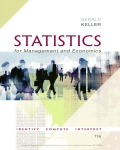
Concept explainers
(a)
Calculate the mean and variance.
(a)
Explanation of Solution
The probability distribution of random variable X is shown below:
Table 1
| X | -2 | 5 | 7 | 8 |
| P(X) | 0.59 | 0.15 | 0.25 | 0.01 |
The mean value of the probability distribution of X is calculated as follows:
The mean value is 1.40.
The variance of the probability distribution of X is calculated as follows:
The variance is 17.04.
Probability distribution: The probability distribution shows the probabilities of incidence of different likely outcomes in a test.
(b)
The probability distribution of Y.
(b)
Explanation of Solution
The probability distribution of Y where Y is equal to 5X is shown in the below table:
| X | -2 | 5 | 7 | 8 |
| Y | -10 | 25 | 35 | 40 |
| P(Y) | 0.59 | 0.15 | 0.25 | 0.01 |
(c)
The mean and variance of Y.
(c)
Explanation of Solution
The mean value of the probability distribution of Y is calculated as follows:
The mean value is 7.
The variance of the probability distribution of Y is calculated as follows:
The variance is 426.
(d)
The expected value and variance of Y.
(d)
Explanation of Solution
The expected value of Y from Parameter X is calculated as follows:
The expected value is 7.
The variance of Y from Parameter X is calculated as follows:
The variance is 426.
Want to see more full solutions like this?
Chapter 7 Solutions
EBK STATISTICS FOR MANAGEMENT AND ECONO
- Answerarrow_forwardM” method Given the following model, solve by the method of “M”. (see image)arrow_forwardAs indicated in the attached image, U.S. earnings for high- and low-skill workers as measured by educational attainment began diverging in the 1980s. The remaining questions in this problem set use the model for the labor market developed in class to walk through potential explanations for this trend. 1. Assume that there are just two types of workers, low- and high-skill. As a result, there are two labor markets: supply and demand for low-skill workers and supply and demand for high-skill workers. Using two carefully drawn labor-market figures, show that an increase in the demand for high skill workers can explain an increase in the relative wage of high-skill workers. 2. Using the same assumptions as in the previous question, use two carefully drawn labor-market figures to show that an increase in the supply of low-skill workers can explain an increase in the relative wage of high-skill workers.arrow_forward
- Published in 1980, the book Free to Choose discusses how economists Milton Friedman and Rose Friedman proposed a one-sided view of the benefits of a voucher system. However, there are other economists who disagree about the potential effects of a voucher system.arrow_forwardThe following diagram illustrates the demand and marginal revenue curves facing a monopoly in an industry with no economies or diseconomies of scale. In the short and long run, MC = ATC. a. Calculate the values of profit, consumer surplus, and deadweight loss, and illustrate these on the graph. b. Repeat the calculations in part a, but now assume the monopoly is able to practice perfect price discrimination.arrow_forwardThe projects under the 'Build, Build, Build' program: how these projects improve connectivity and ease of doing business in the Philippines?arrow_forward
 Managerial Economics: A Problem Solving ApproachEconomicsISBN:9781337106665Author:Luke M. Froeb, Brian T. McCann, Michael R. Ward, Mike ShorPublisher:Cengage Learning
Managerial Economics: A Problem Solving ApproachEconomicsISBN:9781337106665Author:Luke M. Froeb, Brian T. McCann, Michael R. Ward, Mike ShorPublisher:Cengage Learning Managerial Economics: Applications, Strategies an...EconomicsISBN:9781305506381Author:James R. McGuigan, R. Charles Moyer, Frederick H.deB. HarrisPublisher:Cengage Learning
Managerial Economics: Applications, Strategies an...EconomicsISBN:9781305506381Author:James R. McGuigan, R. Charles Moyer, Frederick H.deB. HarrisPublisher:Cengage Learning Economics (MindTap Course List)EconomicsISBN:9781337617383Author:Roger A. ArnoldPublisher:Cengage Learning
Economics (MindTap Course List)EconomicsISBN:9781337617383Author:Roger A. ArnoldPublisher:Cengage Learning






